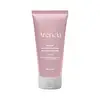What's inside
What's inside
 Key Ingredients
Key Ingredients

 Benefits
Benefits

 Concerns
Concerns

 Ingredients Side-by-side
Ingredients Side-by-side

Glycerin
HumectantWater
Skin ConditioningPrunus Amygdalus Dulcis Oil
Skin ConditioningSodium Cocoyl Glycinate
CleansingCoconut Acid
CleansingXanthan Gum
EmulsifyingHydroxypropyl Starch Phosphate
Polyquaternium-67
Houttuynia Cordata Powder
Skin ConditioningGardenia Florida Fruit Extract
Skin ConditioningDextrin
AbsorbentButylene Glycol
HumectantCitrus Aurantium Amara Flower Oil
MaskingDisodium EDTA
Helianthus Annuus Seed Oil
EmollientSqualane
EmollientPunica Granatum Fruit Extract
AntioxidantOryza Sativa Lees Extract
Skin ConditioningOryza Sativa Extract
AbsorbentAvena Sativa Kernel Extract
AbrasiveHydrogenated Lecithin
EmulsifyingSodium Hyaluronate
HumectantCeramide NP
Skin ConditioningGlycosphingolipids
EmollientPotassium Hyaluronate
Skin ConditioningSodium Hyaluronate Crosspolymer
HumectantHydroxypropyltrimonium Hyaluronate
Hydrolyzed Hyaluronic Acid
HumectantHyaluronic Acid
HumectantHydrolyzed Sodium Hyaluronate
Skin ConditioningPentylene Glycol
Skin ConditioningSodium Acetylated Hyaluronate
HumectantGlycerin, Water, Prunus Amygdalus Dulcis Oil, Sodium Cocoyl Glycinate, Coconut Acid, Xanthan Gum, Hydroxypropyl Starch Phosphate, Polyquaternium-67, Houttuynia Cordata Powder, Gardenia Florida Fruit Extract, Dextrin, Butylene Glycol, Citrus Aurantium Amara Flower Oil, Disodium EDTA, Helianthus Annuus Seed Oil, Squalane, Punica Granatum Fruit Extract, Oryza Sativa Lees Extract, Oryza Sativa Extract, Avena Sativa Kernel Extract, Hydrogenated Lecithin, Sodium Hyaluronate, Ceramide NP, Glycosphingolipids, Potassium Hyaluronate, Sodium Hyaluronate Crosspolymer, Hydroxypropyltrimonium Hyaluronate, Hydrolyzed Hyaluronic Acid, Hyaluronic Acid, Hydrolyzed Sodium Hyaluronate, Pentylene Glycol, Sodium Acetylated Hyaluronate
Glycerin
HumectantWater
Skin ConditioningSodium Cocoyl Isethionate
CleansingSodium Cocoyl Glycinate
CleansingPrunus Amygdalus Dulcis Seed Meal
Abrasive1,2-Hexanediol
Skin ConditioningCoconut Acid
CleansingSodium Methyl Cocoyl Taurate
CleansingCellulose
AbsorbentOryza Sativa Powder
Sodium Isethionate
CleansingPyrus Malus Fiber
AbrasiveGlyceryl Stearate
EmollientHydroxypropyl Starch Phosphate
Propanediol
SolventSodium Chloride
MaskingXanthan Gum
EmulsifyingParfum
MaskingGardenia Florida Fruit Extract
Skin ConditioningCaprylyl Glycol
EmollientDextrin
AbsorbentEthylhexylglycerin
Skin ConditioningDisodium EDTA
Aloe Barbadensis Leaf Extract
EmollientChamomilla Recutita Extract
Skin ConditioningRosa Canina Fruit Extract
AstringentSodium Cocoyl Apple Amino Acids
Skin ConditioningHexylene Glycol
EmulsifyingTetrasodium Glutamate Diacetate
Glycerin, Water, Sodium Cocoyl Isethionate, Sodium Cocoyl Glycinate, Prunus Amygdalus Dulcis Seed Meal, 1,2-Hexanediol, Coconut Acid, Sodium Methyl Cocoyl Taurate, Cellulose, Oryza Sativa Powder, Sodium Isethionate, Pyrus Malus Fiber, Glyceryl Stearate, Hydroxypropyl Starch Phosphate, Propanediol, Sodium Chloride, Xanthan Gum, Parfum, Gardenia Florida Fruit Extract, Caprylyl Glycol, Dextrin, Ethylhexylglycerin, Disodium EDTA, Aloe Barbadensis Leaf Extract, Chamomilla Recutita Extract, Rosa Canina Fruit Extract, Sodium Cocoyl Apple Amino Acids, Hexylene Glycol, Tetrasodium Glutamate Diacetate
 Reviews
Reviews

Ingredients Explained
These ingredients are found in both products.
Ingredients higher up in an ingredient list are typically present in a larger amount.
Coconut Acid isn't fungal acne safe.
Dextrin is used to thicken a product and helps bind ingredients together. It is created from starch and glycogen.
As an emulsifier, dextrin prevents ingredients from separating. This helps elongate a product's shelf life.
Studies show coating UV filters with dextrin prevents these ingredients from being absorbed. This helps UV ingredients last longer on the skin.
Learn more about DextrinDisodium EDTA plays a role in making products more stable by aiding other preservatives.
It is a chelating agent, meaning it neutralizes metal ions that may be found in a product.
Disodium EDTA is a salt of edetic acid and is found to be safe in cosmetic ingredients.
Learn more about Disodium EDTAThis ingredient comes from the evergreen flowering plant, gardenia. It has skin conditioning properties.
Glycerin is already naturally found in your skin. It helps moisturize and protect your skin.
A study from 2016 found glycerin to be more effective as a humectant than AHAs and hyaluronic acid.
As a humectant, it helps the skin stay hydrated by pulling moisture to your skin. The low molecular weight of glycerin allows it to pull moisture into the deeper layers of your skin.
Hydrated skin improves your skin barrier; Your skin barrier helps protect against irritants and bacteria.
Glycerin has also been found to have antimicrobial and antiviral properties. Due to these properties, glycerin is often used in wound and burn treatments.
In cosmetics, glycerin is usually derived from plants such as soybean or palm. However, it can also be sourced from animals, such as tallow or animal fat.
This ingredient is organic, colorless, odorless, and non-toxic.
Glycerin is the name for this ingredient in American English. British English uses Glycerol/Glycerine.
Learn more about GlycerinHydroxypropyl Starch Phosphate is a modified starch used to help thicken a product.
It is also used in foods.
Sodium Cocoyl Glycinate is a cleansing agent. It can be naturally derived or synthetically-created.
As a surfactant, it helps clean your skin by gathering dirt, oil, and other pollutants to be rinsed away more easily.
Water. It's the most common cosmetic ingredient of all. You'll usually see it at the top of ingredient lists, meaning that it makes up the largest part of the product.
So why is it so popular? Water most often acts as a solvent - this means that it helps dissolve other ingredients into the formulation.
You'll also recognize water as that liquid we all need to stay alive. If you see this, drink a glass of water. Stay hydrated!
Learn more about WaterXanthan gum is used as a stabilizer and thickener within cosmetic products. It helps give products a sticky, thick feeling - preventing them from being too runny.
On the technical side of things, xanthan gum is a polysaccharide - a combination consisting of multiple sugar molecules bonded together.
Xanthan gum is a pretty common and great ingredient. It is a natural, non-toxic, non-irritating ingredient that is also commonly used in food products.
Learn more about Xanthan Gum